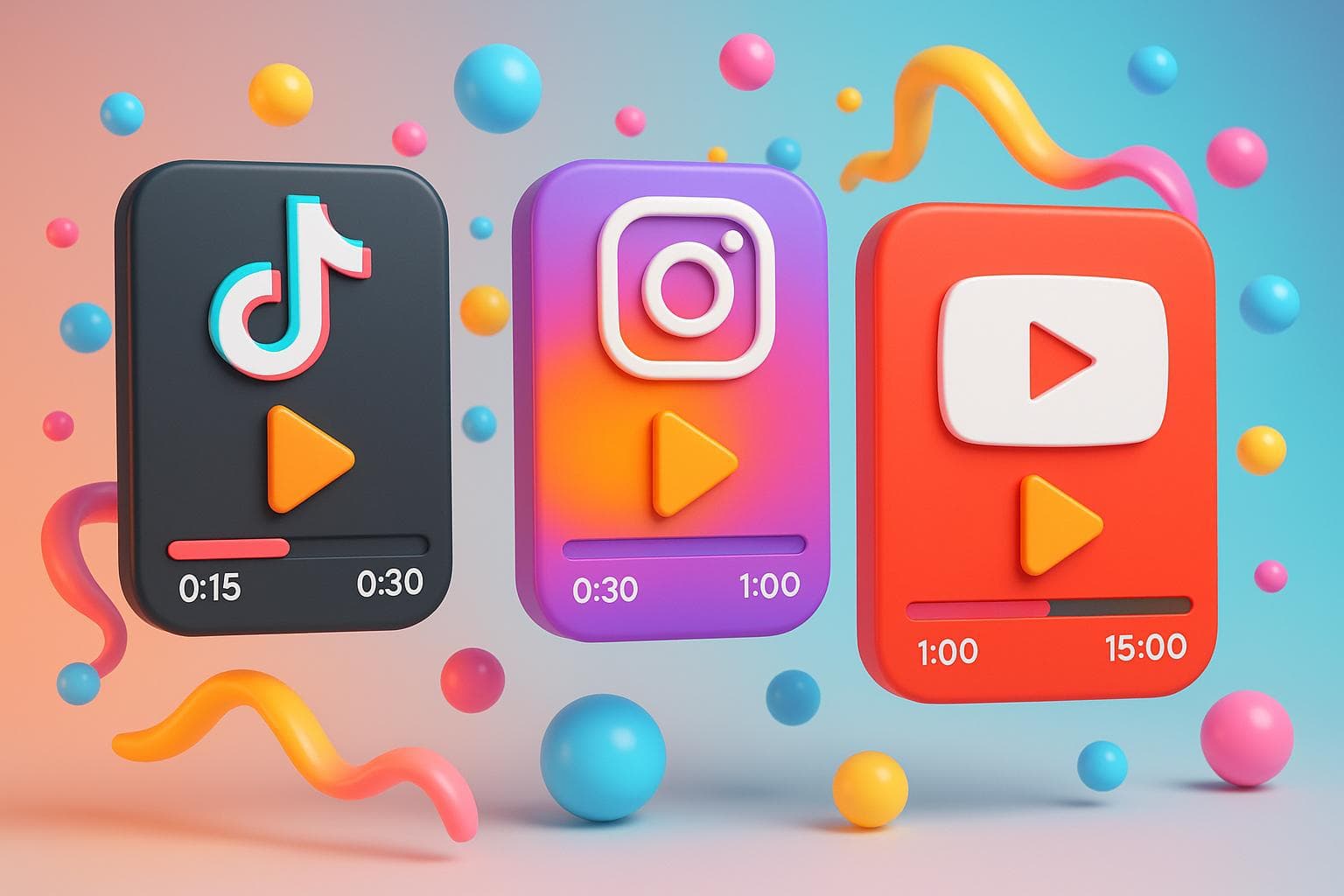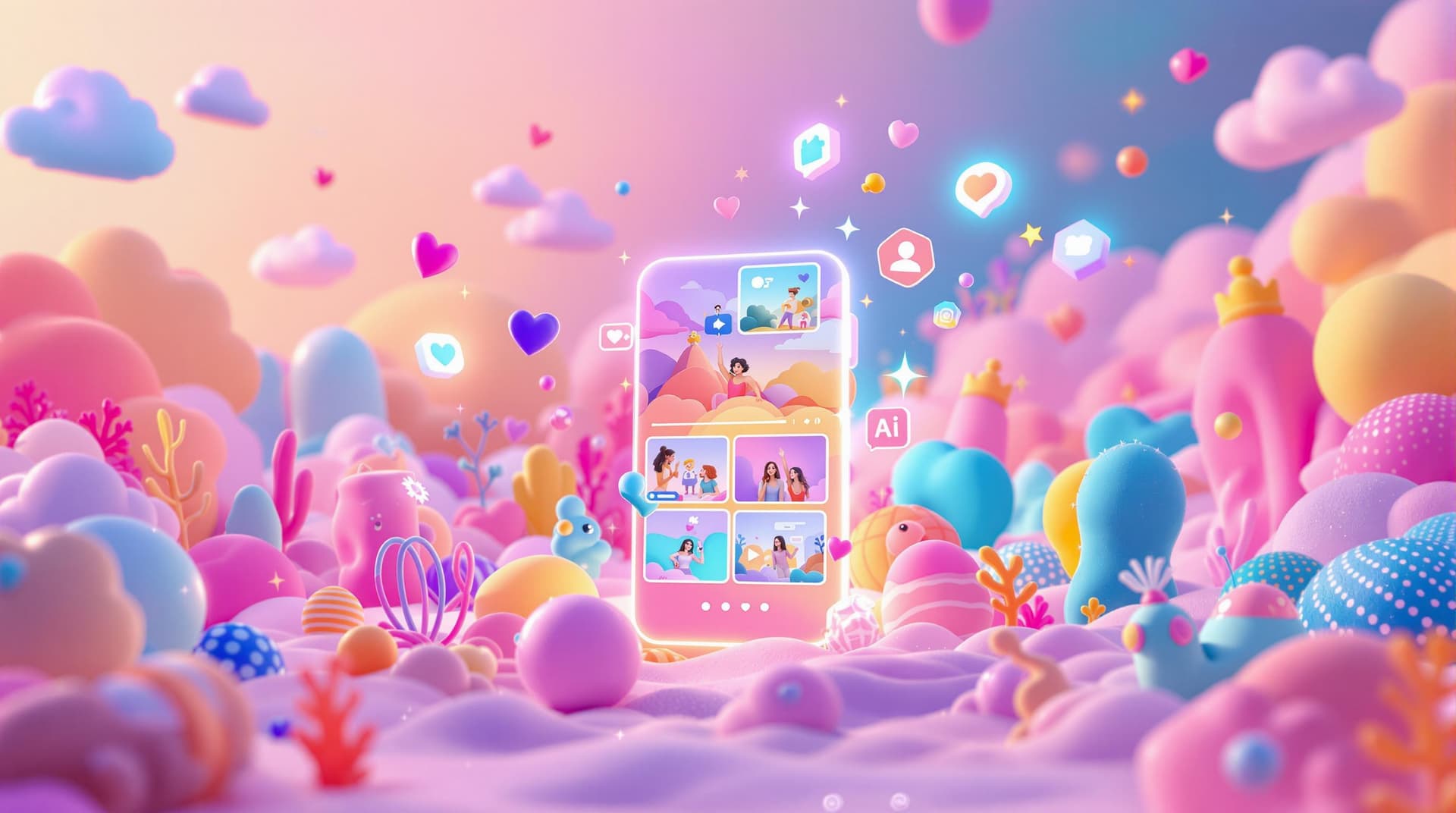
Want more views and engagement on your videos? Start by getting the length right.
Here’s a quick breakdown of the best video lengths for TikTok, Instagram, and YouTube:
- TikTok: While most videos are under 60 seconds, longer ones (60–120 seconds) perform better, with 43.2% more reach and 63.8% more watch time.
- Instagram: Short videos dominate. Reels between 15–30 seconds get the best engagement, while Stories work best at 5–10 seconds.
- YouTube: Longer videos shine. Aim for 7–15 minutes for tutorials or storytelling, as YouTube prioritizes watch time and retention.
Each platform has different algorithms and audience habits, so tailoring your content length is essential. TikTok rewards attention-grabbing openings, Instagram favors short, high-quality clips, and YouTube supports detailed, engaging content.
Quick Tip: Test different lengths to see what works for your audience. Use analytics to refine your strategy and focus on quality over quantity.
The Perfect Video Length to Keep Viewers Watching in 2025
1. TikTok
TikTok has broadened its video length options, offering creators new ways to connect with audiences.
Maximum Video Length
TikTok started with 15-second videos but now allows in-app videos up to 10 minutes and uploads of up to 60 minutes, with tests underway for even longer formats like 20-, 30-, and 60-minute videos. The platform provides a variety of formats tailored to different content needs:
| TikTok Format | Maximum Length |
|---|---|
| Feed Video | 10 mins (60 mins upload testing) |
| TikTok Series | 20 mins per video |
| TikTok Stories | 15 seconds |
| TikTok Ads | 60 seconds (3 mins supported) |
| TikTok Live | 60 mins |
These expanded limits open up opportunities to experiment with how video length affects user engagement.
Optimal Engagement Length
While the majority (86%) of TikTok videos are under one minute, longer content can significantly increase reach and engagement. Videos lasting 60 seconds or more see a 43.2% boost in reach and a 63.8% increase in shares. Data reveals that videos between 21 and 120 seconds perform particularly well, with content over 3 minutes doubling views compared to shorter clips of 6-10 seconds. On average, users now spend 95 minutes daily on TikTok.
Algorithmic Preferences
TikTok's algorithm prioritizes watch time and completion rates. Shorter videos may be completed more often, but longer videos that maintain attention - especially in the first three seconds - can achieve greater reach. In fact, over 63% of top-performing videos deliver key messages within those opening moments.
"A strong indicator of interest, such as whether a user finishes watching a longer video from beginning to end, would receive greater weight than a weak indicator, such as whether the video's viewer and creator are both in the same country." – TikTok Newsroom
This means creators often adapt their video lengths based on algorithmic preferences and their audience's size.
Audience Behavior
Smaller accounts (fewer than 500 followers) tend to post videos averaging 35 seconds, while those with over 50,001 followers average 55 seconds. This suggests that as creators grow their following, they shift toward longer content.
"TikTok has been pushing longer videos, so I'm not surprised by these results. A couple years ago, it was definitely suggested to keep your videos as short as possible, but these days it's all about longer videos." – Mitra Mehvar, Buffer's Social Media Manager
High-quality creators enjoy distinct advantages, including 67% more watch time per video view, three times as many views, and over 40 times the follower growth compared to others.
2. Instagram
Instagram offers a variety of video formats, each tailored to different content goals and ways to engage with your audience.
Maximum Video Length
The platform sets distinct time limits depending on the video type:
| Instagram Video Type | Maximum Length |
|---|---|
| Feed Video | 60 minutes |
| Story | 60 seconds |
| Reel | 90 seconds (Reel ads can extend up to 15 minutes) |
| Live | 4 hours |
| Video Ads (Feed and Story) | 60 minutes |
With 79% of video marketers incorporating Instagram into their strategies, knowing these time limits is essential for planning content effectively.
Optimal Engagement Length
Shorter videos tend to perform better on Instagram. Stories, for example, are typically watched in under 15 seconds, while Reels between 15–30 seconds see the highest completion and replay rates. On average, short-form videos generate 2.5 times more engagement than longer ones. Reels, in particular, boast an engagement rate of 1.23%, outperforming photos (0.70%) and carousels (0.99%). Additionally, users spend about 60% of their time on Instagram watching videos.
Instagram's head, Adam Mosseri, has acknowledged the challenges of these time constraints:
"90 seconds is just too short for those who want to share longer stories".
For best results, aim for the following video lengths:
- Stories: 5–10 seconds
- Reels: 15–60 seconds
- Feed Videos: Under 60 seconds.
Algorithmic Preferences
Instagram's algorithm favors shorter videos. Clips under 15 seconds achieve a 57% completion rate, compared to just 36% for those over a minute. The algorithm prioritizes engagement signals like replays, saves, and watch time to decide which videos get more visibility. Around 75% of users prefer videos that fall within the 15–30 second range. Reels, in particular, can double visibility and drive 22% more interactions than other types of posts. Furthermore, roughly 60% of short-form videos are watched for at least 41–80% of their duration.
Audience Behavior
Instagram users gravitate toward quick, easily digestible content. The first three seconds are critical for grabbing attention, as viewer drop-off rates rise sharply after this brief window. Videos under 15 seconds are especially popular, aligning with the platform's design that encourages users to scroll quickly through posts. To hook viewers early, creators often rely on eye-catching visuals and subtitles.
Next, we’ll dive into YouTube to explore how video length impacts engagement on that platform.
sbb-itb-d822133
3. YouTube
Unlike the quick, snackable content found on TikTok and Instagram, YouTube leans into longer videos and more in-depth engagement.
Maximum Video Length
YouTube stands out with its generous time limits. Verified accounts can upload videos up to 12 hours long, offering creators the flexibility to experiment with a wide range of content formats.
Optimal Engagement Length
For the best viewer engagement, YouTube videos generally perform well in the 7–15 minute range. That said, the ideal length can vary depending on the type of content and audience preferences. Tutorials often shine at 10–20 minutes, while entertainment-focused videos tend to do better in the 5–10 minute range.
YouTuber Aprilynne Alter shares her insight:
"Most people tend to prefer watching videos within the 8–15 minute range".
Fitness creator Olivia Catania highlights the importance of staying true to your style:
"I think creating content at a length that is authentic to you with a clear yet concise message is most important".
Interestingly, the 8-minute mark is notable for monetization, as it’s the minimum length required to include mid-roll ads. This sweet spot allows creators to balance meaningful content with the potential for ad revenue, setting YouTube apart from platforms focused solely on shorter formats.
Algorithmic Preferences
YouTube’s algorithm prioritizes viewer retention and watch time over a specific video length. With 70% of content consumption driven by recommendations, the platform's system focuses on how viewers interact with videos.
Todd Sherman, YouTube Shorts' Senior Director of Product, explains:
"The thing to really think about here is: 'What length do I need to tell my story?' instead of trying to target an exact length. What we are trying to do as a platform is to make sure that videos of any length get the audience they deserve.".
While videos in the 7–15 minute range often perform well, success depends heavily on the niche and content quality.
Audience Behavior
YouTube viewers engage with content differently compared to TikTok or Instagram. According to analytics, videos under a minute average a 50% engagement rate, while videos in the 1–5 minute range see viewers watching about 46% of the content. Longer videos, spanning 5–30 minutes, show strong potential for conversions, achieving an average 10% conversion rate.
For creators aiming to refine their strategy, YouTube Analytics is an invaluable tool. By analyzing audience retention, creators can determine the best video length for their specific audience. The focus should always be on delivering a clear message or compelling story, rather than padding content just to hit a certain time threshold.
Now, let’s dive into the pros and cons of different video length strategies across all three platforms.
Pros and Cons
After diving into the ideal video lengths for various platforms, let’s weigh the benefits and challenges each one brings to the table.
Every platform has its own sweet spot for video length, offering unique opportunities and hurdles for creators.
TikTok gives creators the option to post videos ranging from 3 seconds to a whopping 30 minutes. This flexibility allows for quick, snappy clips or more elaborate storytelling. However, the sheer range can feel overwhelming, especially for new creators. TikTok’s trend-focused nature favors shorter videos for viral potential, but longer ones can foster deeper engagement - if they manage to hold the audience's attention.
Instagram Reels falls in the middle ground with videos between 15 seconds and 3 minutes. Its seamless integration with Instagram Stories and the main feed makes cross-promotion easy. However, Instagram’s algorithm seems to prefer shorter content, with videos over 90 seconds often experiencing reduced reach. Plus, the platform’s focus on high-quality visuals means creators need polished production to stand out.
YouTube caters to a wide range of content lengths, from 15 seconds to a staggering 12 hours. While this allows for everything from bite-sized clips to detailed tutorials and narratives, the platform’s algorithm tends to reward videos that keep viewers engaged for longer periods. This opens the door for in-depth storytelling and monetization opportunities, but it also raises the bar for production, requiring more time, planning, and editing expertise - a potential roadblock for beginners.
| Platform | Length Range | Key Advantage | Main Challenge |
|---|---|---|---|
| TikTok | 3 seconds - 30 minutes | Flexibility for short clips or long stories | Overwhelming options; trend-driven success |
| Instagram Reels | 15 seconds - 3 minutes | Easy cross-promotion with Stories and feed | Shorter videos favored; high production needed |
| YouTube | 15 seconds - 12 hours | Perfect for detailed storytelling and monetization | High production demands for engagement |
These differences highlight the importance of crafting a content strategy that aligns with both the platform’s strengths and the audience’s preferences.
Adapting content across platforms can be tricky. What works on one platform often needs tweaking to succeed on another. For instance, TikTok thrives on raw, fast-paced content, while YouTube rewards detailed, polished videos. Instagram lands somewhere in between, requiring visually appealing yet concise content.
Audience expectations also vary widely. TikTok users typically crave instant entertainment, Instagram users lean toward aesthetically pleasing visuals that blend into their feeds, and YouTube viewers are more willing to invest time in longer, detailed content. Understanding these differences is key to creating platform-specific content that resonates.
For creators using tools like MagicUGC, these platform nuances become even more important. MagicUGC simplifies the process of crafting content tailored for each platform, eliminating the need for manual editing and ensuring videos meet audience expectations effortlessly.
Conclusion
Getting the length of your videos right can make a huge difference in how your content performs. For TikTok, videos over 60 seconds tend to perform well, even though most users stick to shorter clips. Instagram Reels often shine with snappy 15–30 second videos, while YouTube engages viewers best with longer content in the 7–15 minute range. Each platform has its own sweet spot, which means your strategy needs to adapt to meet these unique expectations.
Interestingly, video completion rates have jumped by 11% year-over-year. And with the average person spending close to seven hours a week watching videos, how you tailor your video lengths can have a big impact on engagement.
Matching video length to the platform is key. A quick 15-second TikTok might need to be stretched into a 2-minute YouTube clip, or perhaps condensed into a 7-second Instagram Reel. Each platform has its own audience behaviors and algorithms, so there’s no one-size-fits-all approach.
Testing and experimenting are your best tools here. As Reddit user ModRod wisely pointed out:
"Don't pay attention to averages. They don't really mean anything. Experiment and test. Collect all the data you can. You'll figure it out that way."
– ModRod, Reddit User
It’s also important to grab attention within the first few seconds and optimize for mobile viewing. Clear visuals and captions can make all the difference. The goal isn’t to hit a specific number of seconds - it’s to create content that resonates with your audience and aligns with your goals for each platform.
For creators and brands juggling multiple platforms, MagicUGC offers a game-changing tool. Using AI models trained on over 1 million high-performing Instagram and TikTok videos, MagicUGC automatically generates content that’s optimized for each platform. This means you can skip the manual editing and focus on your message, while the technology handles the tricky details like formatting and length.
FAQs
What are the ideal video lengths for TikTok, Instagram, and YouTube to boost engagement?
The best video length depends on the platform you're using, as each caters to different audience habits and algorithmic preferences:
- TikTok: Quick clips under 10 seconds often do well, but engaging videos over 54 seconds can also perform impressively.
- Instagram Reels: Aim for 15-30 seconds to create snappy, attention-grabbing content.
- YouTube: While videos under 2 minutes tend to get the most engagement, longer, well-crafted videos (6-12 minutes) can also resonate with viewers.
Overall, shorter videos are great for grabbing attention fast, but it's essential to match your video's length to the platform and your specific content goals to see the best results.
What are the ideal video lengths for TikTok, Instagram, and YouTube to maximize engagement?
To get the most out of your videos, tailor their lengths to fit each platform’s strengths. For TikTok and Instagram, short clips - ideally 15-30 seconds - work wonders. These platforms thrive on fast, captivating content that grabs attention instantly. On YouTube, however, longer videos between 8-15 minutes tend to perform better. This format gives creators the chance to dive deeper into topics and foster stronger connections with their audience.
Keep an eye on your analytics to see how viewers are interacting with your content. Use this data to fine-tune your video lengths, ensuring they align with both platform trends and your audience's preferences.
What’s the best way to find the ideal video length for TikTok, Instagram, and YouTube?
To determine the best video length for each platform, start by experimenting with different durations. For instance, try 15–30 seconds for TikTok and Instagram Reels or 2–3 minutes for YouTube. Monitor key metrics like view duration, audience retention, and engagement rates to identify what your audience responds to most.
Each platform caters to distinct viewer behaviors and algorithm preferences, so testing is crucial. Generally, shorter videos tend to perform better on fast-moving platforms like TikTok, while YouTube audiences often prefer longer, more in-depth content. Tailor your approach to align with your audience's preferences and viewing habits.



